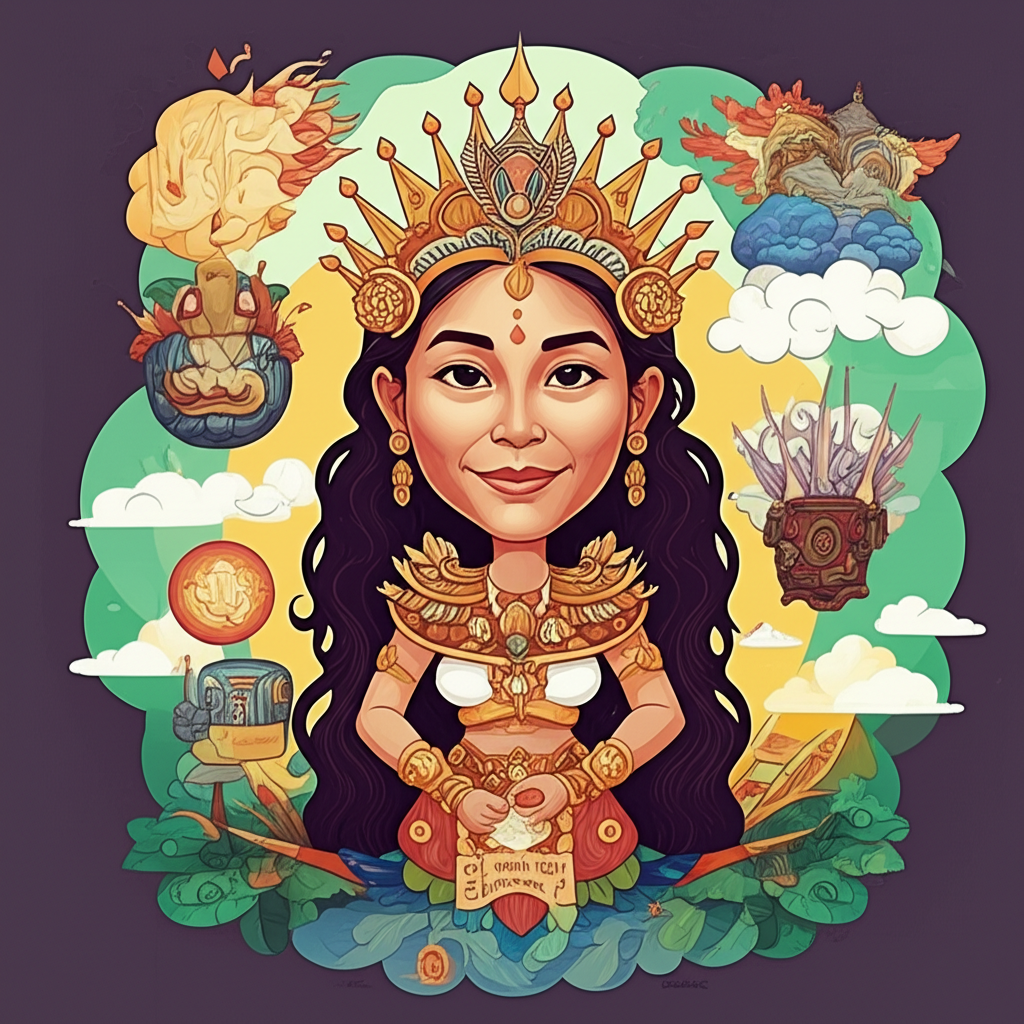
In the tapestry of human history, woven with threads of shared experiences, anxieties, and aspirations, lie the ancient stories that attempt to explain the unfathomable: the origin of the world and all within it. Among the rich cultural heritage of the Philippines, specifically among the Tagalog people of Luzon, such tales echo through generations. This article delves into one such creation narrative, focusing on the figure of Anitun Tabu and the journey of these ancient Tagalog genesis stories. It is crucial to preface this exploration by stating that these are traditional narratives, passed down orally, reflecting the worldview of ancient peoples and not intended as literal accounts or to be worshipped. Our understanding of these stories is for cultural, historical, and educational enrichment.
Origins and Cultural Background: Echoes of a Pre-Colonial World
The myths of creation, including those involving Anitun Tabu, emerged from a pre-colonial Tagalog society. This was a time when life was intimately intertwined with the rhythms of nature. The archipelago, a verdant expanse dotted with volcanoes and fringed by vast oceans, dictated the daily lives of its inhabitants. The Tagalogs, like many indigenous groups, lived in close proximity to the natural world, attributing agency and spirit to the sun that warmed their crops, the winds that carried their boats, the rivers that sustained their communities, and the earth that provided their sustenance.
Their worldview was animistic, a belief system where spirits inhabited all aspects of nature. The world was not a passive entity but a vibrant, living realm populated by unseen forces. The challenges of survival – typhoons that ravaged villages, earthquakes that shook the ground, and the ever-present mystery of life and death – fueled a desire for understanding. Creation myths served as the intellectual and spiritual framework for these societies, offering explanations for existence, establishing moral codes, and providing a sense of order in a world that could often feel chaotic and unpredictable. These stories were not mere entertainment; they were integral to their understanding of themselves and their place in the cosmos.
Character/Creature Description: Anitun Tabu, the Breath of Creation
Within the Tagalog pantheon of mythical beings, Anitun Tabu occupies a significant, though sometimes fluid, position. Often described as a goddess or a powerful spirit, Anitun Tabu is associated with the winds. Her name itself, "Anitun," can be interpreted as "wind" or "breeze," and "Tabu" can signify a prohibition or a sacred place. This suggests a being connected to the intangible forces of nature, perhaps the very breath that animates the world.
Symbolically, Anitun Tabu represents the unseen forces that shape the environment and, by extension, life itself. The wind, in many cultures, is a potent symbol of change, power, and the ephemeral. It can be gentle and life-giving, nurturing crops and carrying the scent of blossoms, or it can be destructive and fearsome, unleashing storms and reshaping landscapes. Anitun Tabu embodies this duality. She is not depicted with a fixed, physical form in the same way a human might be. Instead, her presence is felt through the rustling of leaves, the sighing of the wind through bamboo groves, and the powerful gusts that precede a storm. She is the animating principle, the invisible force that sets things in motion.
Main Story/Narrative Retelling: The Genesis from the Winds
The genesis tales involving Anitun Tabu vary in their specifics, as is common with oral traditions passed down through generations. However, a common thread depicts her as instrumental in the initial stages of creation. One iteration of the myth tells of a time before existence, a void, a boundless expanse of nothingness. Within this primordial stillness, there was only the nascent consciousness of Anitun Tabu, the embodiment of the potential for movement and breath.
It is said that Anitun Tabu, restless and alone in the emptiness, began to stir. Her first movements were gentle breezes, whispers of possibility within the void. These breezes, imbued with her essence, began to gather and swirl, coalescing into form. As she continued to breathe, her exhalations became more potent, shaping the formless into substance.
From her initial breaths, it is believed, emerged the sky and the earth. Some narratives suggest that Anitun Tabu, in her creative fervor, spun the heavens from the finest threads of her breath, creating the vast expanse above. The earth, in contrast, was formed from the denser currents of her exhaled winds, solidifying into the ground upon which life would eventually flourish.
Other versions of the story describe a giant bird or a celestial serpent as being instrumental, and Anitun Tabu’s role might be that of the force that awakens or guides these entities. For instance, a great bird might have been dormant, and Anitun Tabu’s winds were the stimulus that roused it, causing it to flap its wings and create the world. Or, a cosmic serpent might have coiled in the void, and Anitun Tabu’s breath caused it to unfurl, its movements shaping the land and sea.
Regardless of the precise details, Anitun Tabu’s power is intrinsically linked to the act of breathing, movement, and the shaping force of the wind. She is not a sculptor with hands, but a force that molds through her very being, her presence felt in the dynamic processes of the nascent universe. The initial acts of creation are thus presented as a grand, elemental dance, orchestrated by the unseen breath of this powerful spirit.
Symbolism and Meaning: The Breath of Life and Change
For the ancient Tagalogs, the story of Anitun Tabu and the genesis of the world likely held profound symbolic meaning. The wind, as her domain, represented the essential animating force of life. Without breath, there is no life. Her creation of the sky and earth through her exhalations mirrored the fundamental elements necessary for existence.
The duality of the wind also spoke to the unpredictable nature of their world. The gentle breezes that ripened their rice fields were a blessing from Anitun Tabu, while the destructive typhoons were a reminder of her formidable power and the need for respect and appeasement. This dualistic understanding of nature, where benevolent and malevolent forces were often intertwined, was a common feature of many ancient mythologies.
Furthermore, Anitun Tabu’s role as a primordial creator could have represented the concept of change and transformation. The wind is a constant agent of change, shaping coastlines, moving clouds, and carrying seeds. Her creation story, therefore, could have symbolized the inherent dynamism of the universe, a world in perpetual motion and evolution. It offered a framework for understanding the cycles of nature – the changing seasons, the ebb and flow of tides, and the very process of life and decay.
Modern Perspective: Echoes in Contemporary Culture
While Anitun Tabu and the Tagalog creation myths are no longer believed as literal truths, their influence resonates in modern Filipino culture, particularly in literature, art, and academic discourse. These stories are studied by folklorists and anthropologists, providing invaluable insights into the cultural evolution and philosophical underpinnings of the Tagalog people.
In contemporary literature, authors may draw inspiration from these myths to imbue their narratives with a sense of historical depth and cultural authenticity. Characters might bear names reminiscent of these ancient deities, or plotlines could echo themes of creation, elemental forces, and the relationship between humanity and the natural world. In visual arts, motifs and symbols derived from these myths can be incorporated into paintings, sculptures, and digital art, reinterpreting them for a modern audience. While not as prevalent in mainstream film and games as some other mythologies, there is a growing appreciation for indigenous folklore, and these stories offer a rich source of unique narrative potential.
Conclusion: A Legacy of Imagination and Storytelling
In concluding our exploration, it is vital to reiterate that Anitun Tabu and the genesis tales of the Tagalog people are cherished cultural narratives, products of ancient human imagination striving to comprehend the mysteries of existence. As Muslims, we recognize that the sole and true Creator and Sustainer of all that exists is Allah (SWT). Our understanding of these myths is for the appreciation of cultural heritage, the exploration of human creativity, and the rich tradition of storytelling that connects us to our past.
These ancient tales, passed down through generations, serve as a testament to the enduring human need to make sense of the world. They highlight the profound connection our ancestors felt with the natural environment and their attempts to imbue the unseen forces of nature with meaning. The journey of these creation stories, from whispered tales around campfires to academic study today, underscores the power of narrative to shape identity, preserve cultural memory, and remind us of the vast and wondrous tapestry of human thought and imagination. They are not to be believed as divine pronouncements, but rather as invaluable artifacts of our shared human experience, offering a glimpse into the minds and hearts of those who came before us.





